Discover the Charm of the Canal Belt Amsterdam: History, Hotels, and Highlights
The Canal Belt Amsterdam, known in Dutch as the ‘Grachtengordel,’ is a UNESCO World Heritage site famous for its historic canals, elegant architecture, and vibrant cultural life.
The canal belt was developed as an ambitious expansion beyond Amsterdam’s original medieval city core, marking a striking contrast between the compact, historic medieval city and the later, grand urban planning of the canal belt.
Join us as we explore the origins of the Canal Belt Amsterdam, dive into its iconic landmarks, and uncover the best sights and experiences along these historic waterways.
Introduction to the Canal Belt
The Amsterdam Canal Belt, or “Grachtengordel,” is one of the most iconic and historic areas in the Netherlands, right in the heart of Amsterdam. Recognized as a UNESCO World Heritage Site, this enchanting canal district is renowned for its beautiful 17th-century canal houses, elegant bridges, and tranquil inner gardens. Built during the Dutch Golden Age, the canal belt stands as a testament to Amsterdam’s rich history, innovative town planning, and the city’s mastery of water management. Visitors are drawn to the area’s main canals—Herengracht (Gentlemen’s Canal), Keizersgracht (Emperor’s Canal), and Prinsengracht (Prince’s Canal)—each lined with stunning canal houses that reflect the prosperity and artistry of the era. Whether you’re wandering through the leafy streets or admiring the intricate network of canals, the Amsterdam canal belt offers a glimpse into the city’s golden age and its enduring charm.
Key Takeaways
- Amsterdam’s Canal Belt, a UNESCO World Heritage site, showcases innovative urban planning from the 17th century, impacting cities globally.
- The Golden Bend area features grand mansions reflective of the wealth during the Dutch Golden Age and remains a symbol of historical luxury.
- Visitors can enjoy a mix of history, culture, and vibrant events along the canals, from museums to annual celebrations like the Canal Parade.
The Origins of Amsterdam’s Canal Belt
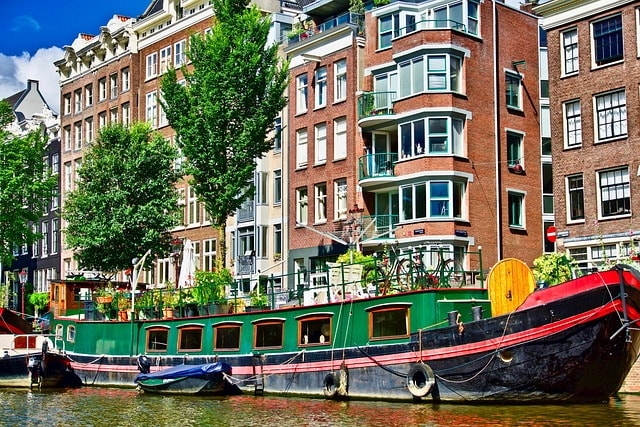
Amsterdam’s canal belt, a marvel of urban planning, is a network of concentric canals that form concentric belts and serve as the backbone of the city. Constructing this intricate system required extensive land reclamation and marshland drainage, demonstrating Dutch mastery in hydraulic engineering. Developed in the late 16th and 17th centuries, Amsterdam’s canals were built during the Dutch Golden Age as part of a project to create a new port city to accommodate Amsterdam’s rapid growth, driven by economic prosperity and a population surge during this period.
Amsterdam’s canal belt set a precedent in urban design, influencing cities worldwide and marking a significant advancement in urban extension and design of its era. The four canals—Singel, Herengracht, Keizersgracht, and Prinsengracht—were constructed in the 17th century and served both residential and commercial purposes. The Singel Canal, as the outermost canal, holds historical significance and is a key part of the city’s UNESCO World Heritage status. The canal belt spans more than 100 kilometers of canals and includes over 1,500 bridges, showcasing the city’s impressive infrastructure. These canals not only facilitated trade and transport but also played a crucial role in the city’s infrastructure, influencing urban design, mobility, and environmental management.
Amsterdam aims to become energy neutral by 2050, exploring sustainable heating solutions connected to its canal system. The canal belt area is notable for its uniform architectural style and the city’s numerous historical monuments, creating a cohesive urban ensemble that captivates residents and visitors alike.
City Center Location
Perfectly situated in the city center, the Amsterdam Canal Belt is the beating heart of the city and an ideal starting point for any visit. The canal belt’s central location means you’re never far from Amsterdam’s most famous attractions, including the Anne Frank House, Dam Square, and the lively Vondelpark. With beautiful canal houses lining every street and a wealth of museums, restaurants, and shops within easy walking distance, the area is both vibrant and convenient. Whether you’re exploring the city’s rich history, enjoying a meal at a canal-side restaurant, or simply soaking up the atmosphere, the Amsterdam canal belt puts you right at the center of it all.
Private Boat Tours on the Canal Belt Amsterdam
Exploring the Amsterdam Canal Belt by private boat is an experience not to be missed. A boat tour offers a unique perspective on the city, allowing you to glide past historic canal houses, under charming bridges, and alongside some of Amsterdam’s most famous landmarks. Private Luxury Boat Tours start for 250 EUR for the first hour including a welcome drink. Contact +31 6 45 25 1000 for more information or visit amsterdamprivateboat.com to book.

The private boat tours from BoatBoys Amsterdam provide fascinating commentary on the city’s history and architecture, with highlights including the Anne Frank House, the majestic Western Church, and the iconic Skinny Bridge. Whether you choose a daytime cruise or a romantic evening tour, seeing the city from the water reveals the true beauty and ingenuity of the Amsterdam canal belt.

Walking Tours on the Canal Belt Amsterdam
The Amsterdam Canal Belt is a delight to explore on foot, with its compact layout and pedestrian-friendly streets inviting visitors to discover its many treasures. Walking tours lead you along the Emperor’s Canal and other main canals, where you can admire the beautiful canal houses and learn about the area’s rich history. The canal belt is home to some of Amsterdam’s most renowned museums, such as the Rijksmuseum and the Van Gogh Museum, as well as countless hidden gems waiting to be uncovered. Whether you join a guided tour or set out on your own, strolling through the Amsterdam canal belt is the perfect way to experience the city’s vibrant atmosphere, stunning architecture, and centuries-old charm.
UNESCO World Heritage Status
The cultural and historical significance of Amsterdam’s Canal Belt earned it a place on the UNESCO World Heritage list in 2010. This prestigious status highlights the canal belt’s role in shaping Amsterdam’s identity and heritage, emphasizing its importance not just to the city but to global heritage as well. The Canal Belt demonstrates urban planning on a large scale and remained influential in urban development until the 19th century. This recognition celebrates the innovative urban planning and architectural elegance defining the canal belt area.
Houses on Herengracht, often called the ‘Patricians’ Canal,’ have maintained their value over centuries, underscoring their status as prime real estate. The Herengracht is the most fashionable of the main canals, lined with prestigious mansions. These notable buildings are a testament to the enduring charm and historical importance of Amsterdam’s canal district.
Strolling along these canals offers a glimpse into the past, where the wealth and prosperity of the Dutch Golden Age remain palpable.
Iconic Canals and Their Features
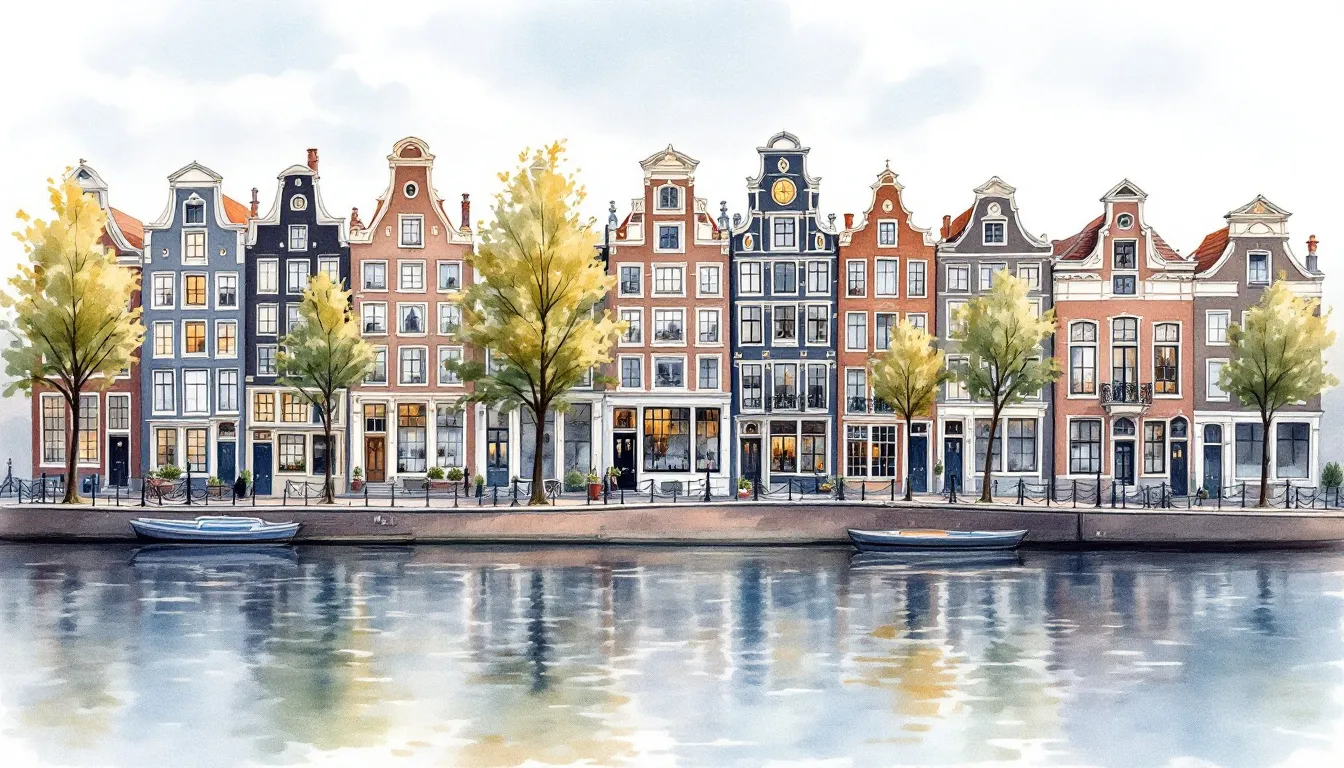
The core of Amsterdam’s canal belt comprises three major canals, each with its unique charm and features:
- Prinsengracht
- Herengracht
- Keizersgracht (Emperor’s Canal), which is the widest of the main canals, named in honor of the Holy Roman Emperor. Emperor’s Canal boasts several notable historical buildings along its banks, attracting history enthusiasts.
The architectural elegance of the 17th century canal is evident along these canals, with grand canal houses harmoniously integrated with the waterways. The Western Church, located along the Prinsengracht, is notable for its 85-meter tall tower, which stands as a key religious and historical site in the lords canal western canal belt. The church was designed by Hendrick de Keyser, whose architectural vision greatly influenced Amsterdam’s early development.
The canal ring that encloses Amsterdam’s historic center is a marvel of town planning, forming concentric belts that are both functional and beautiful. The western part of the canal belt, in particular, highlights the scenic and cultural importance of this area. Exploring the canal belt area provides lovely canal views and a chance to appreciate the meticulous design preserving Amsterdam’s charm for centuries, including Amsterdam’s semicircular ring.
Whether you’re wandering along the innermost canal or admiring the beautiful canal houses, the Amsterdam canal district never fails to enchant.
The Golden Bend
The Golden Bend, or Gouden Bocht, is the most exclusive stretch of Herengracht in Amsterdam, renowned for its double-wide mansions. Historically, this area was home to Amsterdam’s wealthiest residents, contributing to its reputation as the most fashionable part of the city. The grandeur of the Golden Bend is evident in its architectural style, which often features classicist facades, decorated ceilings, and well-maintained gardens.
Notable buildings in the Golden Bend include the Huis van der Graeff, built in 1672 by burgomaster Andries de Graeff. Known as the Patricians’ Canal, Herengracht encouraged upscale development, motivating buyers to purchase two lots, resulting in larger, elegantly designed mansions.
This area remains a symbol of the Dutch Golden Age’s wealth and architectural sophistication in the Netherlands, attracting tourists who wish to glimpse the opulence of the past.
Living in the Canal Houses
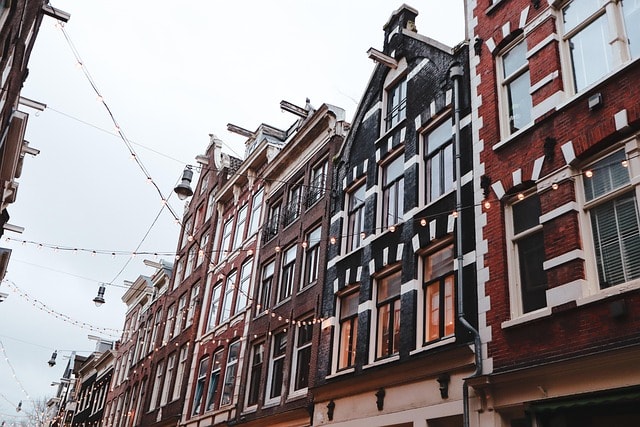
Living in Amsterdam’s canal houses provides a unique and charming experience. The narrow plots of land along the canals necessitated the construction of closely packed canal houses. These beautiful canal houses, primarily built in the 17th century, are a hallmark of the Amsterdam canal district, giving the city its distinctive and picturesque appearance.
Despite the narrow plots, houses were densely packed along the canal rings, creating a vibrant urban landscape. Many of these houses have been meticulously preserved, allowing residents and visitors to experience the historical ambiance of central Amsterdam.
The charm of living in historic surroundings with the city’s canal views is unmatched.
Exploring the Western Canal Belt
The western canal belt is home to some of Amsterdam’s most significant landmarks. Dam Square, in the heart of the city, is a central hub known for its historical buildings and lively events. The square extends from west to east, connecting key streets and landmarks within the city’s layout. This vibrant area is a must-visit for experiencing the energy and history of Amsterdam.
Located along Prinsengracht, the Anne Frank House serves as a poignant museum, offering insight into Anne Frank’s life during World War II.
Another notable site is the Torensluis Bridge, the widest and one of the oldest bridges in Amsterdam, built in the 17th century. This bridge is significant for its historical architecture and offers a unique perspective on the city’s rich history.
Museums Along the Canals
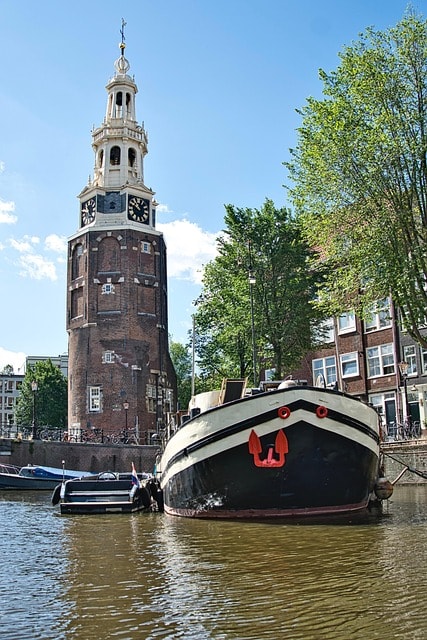
Amsterdam’s canal belt is home to several museums that offer a deep dive into the city’s rich history and culture. Museum Square, located nearby, is home to several of Amsterdam’s most famous museums and serves as a central cultural hub. The Anne Frank House, located along Prinsengracht, offers a touching perspective on Anne Frank’s life during World War II and is a must-visit for those interested in the poignant history of the Jewish community during the war.
Houseboat Museum on the Prinsengracht (5min walk from Anne Frank)
The Houseboat Museum is a unique and interactive way to discover the Amsterdam houseboat lifestyle. Explore this freight ship from 1914 which got turned into a funky residential houseboat in 1967. See first hand how it was used back in the day and how much space they got when it was refurbished as a boat house. Rated with a 4.4 on Google it is one of the top museums of the canals.
Other museums along the canals
The Museum of the Canals is another fascinating destination, showcasing Amsterdam’s canal history through an engaging audiovisual exhibition that spans 400 years. For something a bit more whimsical, the Kattenkabinet is a unique museum dedicated to cat art, located in a canal house that often includes real cats among its exhibits.
Museum van Loon features a lovely garden, a surprising find for visitors exploring the area. The hidden gardens of the Museum Willet-Holthuysen provide a glimpse into the lavish lifestyle of Amsterdam’s wealthy during the Golden Age. These museums enrich your understanding of Amsterdam while offering serene spots to relax and enjoy the city’s beauty.
Hotels with Lovely Canal Views
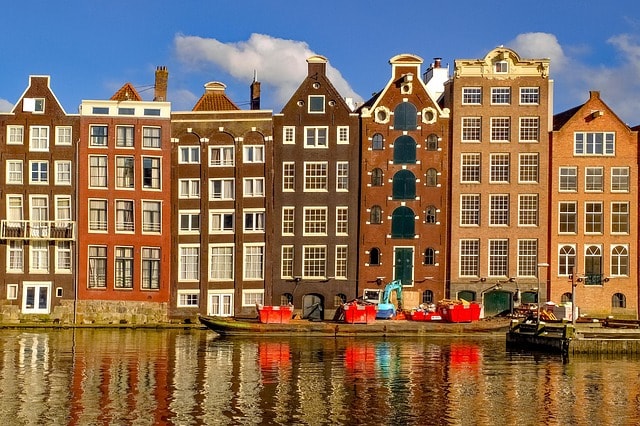
Staying in the best hotels with canal views immerses visitors in the charm of Amsterdam’s picturesque waterways. The Hotel Toren offers luxurious accommodations in two historic townhouses, featuring opulent decor and modern amenities. Another excellent choice is Seven One Seven, a former sugar merchant’s residence with classic elegance, oak paneling, and antique furnishings.
Mokum Suites offers a boutique B&B experience with stylish interiors and picturesque canal views, perfect for a romantic getaway. The Max Brown Hotel combines a stylish atmosphere with a historical setting, offering guests stunning views over Herengracht canal.
Located within easy walking distance of many attractions, these hotels provide an ideal base for exploring Amsterdam’s canal district.
Events and Activities
Amsterdam’s canal belt is not just about history and architecture; it’s also a hub of vibrant events and activities. The Amsterdam City Swim, an annual fundraising event, involves swimming in the canals to support ALS research. This unique event attracts participants and spectators from around the world, adding a lively atmosphere to the canal district, near the Amstel River. During the winter months, the Amsterdam Light Festival features unique light installations viewable from heated canal boats, creating a magical experience for visitors.
The Canal Parade, part of Amsterdam Pride, features a colorful boat procession through the canals. National Tulip Day celebrates tulip blooming with a free bouquet giveaway in the city’s canals.
The Amsterdam Canals Festival features classical music concerts on boats and canal-side locations, offering a magical experience for music lovers. These events showcase Amsterdam’s dynamic spirit and provide unforgettable experiences for visitors.
Hidden Gems and Inner Gardens
Amid the hustle and bustle of Amsterdam’s canal belt, hidden gems and inner gardens offer a peaceful retreat. The Begijnhof is a tranquil courtyard, one of Amsterdam’s oldest hofjes, providing a serene escape. Karthuizerhof is another private hofje, offering a quiet environment perfect for reflection.
Open Garden Days invite visitors to explore private gardens and hidden courtyards in the canal district. The Museum of the Canals features a special exhibition on the wildlife found within the Amsterdam canals, introducing visitors to the diverse fauna that call these waterways home.
These hidden gems add charm to the canal belt, making exploration even more rewarding.
Water Management and Bridges
Both population pressure and the need for efficient water management prompted the construction of Amsterdam’s canal belt. Meticulously designed to manage water levels and prevent flooding, the canals showcase the city’s expertise in hydraulic engineering. Amsterdam’s population growth in the early 17th century necessitated the expansion of the city to accommodate new residents and trade. The Roboat initiative explores using autonomous boats in Amsterdam’s canals to alleviate urban traffic and enhance waterway use.
Amsterdam’s bridges are equally impressive, with some dating back over 300 years. Amsterdam’s 3D printed smart bridge, equipped with sensors, gathers real-time data to enable better transportation and maintenance of urban infrastructure.
The city’s quays and bridges require innovative assessment techniques to ensure safety and longevity, reflecting a commitment to preserving Amsterdam’s historical and functional integrity.
Photography Opportunities
For photography enthusiasts, the Amsterdam Canal Belt is a dream come true. The picturesque canals, historic bridges, and rows of beautiful canal houses provide endless inspiration for capturing the city’s unique character. Lovely canal views abound at every turn, especially during the golden hours of sunrise and sunset when the light dances on the water and highlights the city’s timeless architecture. From the reflections in the canals to the intricate details of the 17th-century houses, every corner of the Amsterdam canal belt tells a story—making it the perfect backdrop for unforgettable photos.
Summary
Amsterdam’s Canal Belt is a great example of innovation and prosperity, reflecting the city’s rich history and meticulous urban planning. Often referred to as the ‘Venice of the North,’ the beauty and symmetry of the canal belt are evident in the grand canal houses built by affluent merchants along its waterways, offering a glimpse into the past while seamlessly integrating with the modern city.
The canal belt exemplifies Amsterdam’s ability to blend historical charm with contemporary living. From its iconic canals and notable buildings to hidden gems and vibrant events, the canal district captures the city’s unique character and enduring appeal.
Frequently Asked Questions
Why is Amsterdam’s Canal Belt considered a UNESCO World Heritage site?
Amsterdam’s Canal Belt is a UNESCO World Heritage site because of its rich historical and cultural importance. Along with its impressive urban planning and beautiful architecture. It’s a stunning example of human creativity and ingenuity!
What are some notable museums along the canals?
You can’t miss the Houseboat Museum, Anne Frank House and the Museum of the Canals along the canals. Each museum provide a fascinating glimpse into Amsterdam’s rich history and culture. Enjoy exploring these gems!
What events take place in Amsterdam’s Canal Belt?
Amsterdam’s Canal Belt buzzes with exciting events like the Amsterdam City Swim, Canal Parade, National Tulip Day, and the Amsterdam Canals Festival. These event make it a lively spot to experience the city’s culture. So, if you’re in the area, make sure to join in on the festivities!
What makes the Golden Bend special?
The Golden Bend is special because it’s the most exclusive part of the Herengracht. It showcases stunning double-wide mansions that reflect Amsterdam’s rich history and its wealthiest residents from the Dutch Golden Age. It’s a slice of luxury and heritage right in the heart of the city!
How is water management handled in Amsterdam’s Canal Belt?
Water management in Amsterdam’s Canal Belt is efficiently handled through innovative projects like the Roboat initiative and smart 3D-printed bridges. These optimize the use of waterways and protect the city’s infrastructure. It’s a great example of how technology can enhance urban living while tackling water-related challenges.

